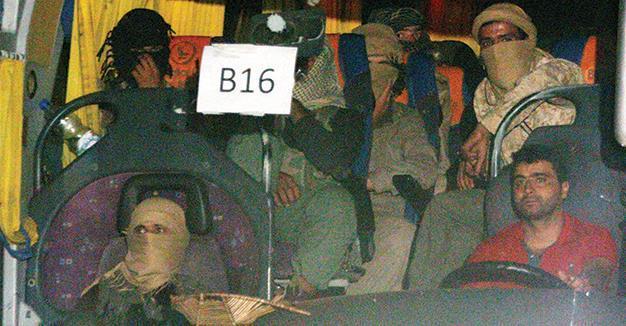Russian airstrike kills around 40 ISIL militants in Syria, including one ‘linked to’ 2015 Paris attacks
MOSCOW/WASHINGTON

Russia said on Sept. 8 to have killed several top commanders of the Islamic State of Iraq and the Levant (ISIL) group in an airstrike in Syria, including the “minister of war” who has a bounty on his head.
“As a result of a precision air strike of the Russian air forces in the vicinity of Deir al-Zor city, a command post, communication centre and some 40 ISIL fighters have been killed,” the Russian defence ministry said in a statement posted on Facebook.
“According to confirmed data, among the killed fighters are four influential field commanders including Deir al-Zor emir Abu Mohammed al-Shimali,” the ministry said.
Apart from smuggling the recruits into Syria, al-Shimali was named by “several European intelligence agencies” as one of the organizers of the fatal November 2015 Paris attacks, the ministry added.
Media reports have previously indicated that French investigators established that at least three of the attackers arrived to France via refugee roots, with at least one of them obtaining a fake passport from ISIL.
Al-Shimali (also known as Tirad Al-Jarba) was an Iraqi-born Saudi Arabia citizen who defected from Al-Qaeda to ISIL in 2015.
The same year, the U.S. State Department offered a bounty of up to $5 million for information leading to al-Shimali’s capture, describing him as “a key leader in ISIL’s Immigration and Logistics Committee” overseeing “smuggling activities, financial transfers, and the movement of supplies into Syria and Iraq from Europe, North Africa, and the Arabian Peninsula.”
The ministry said that Gulmurod Khalimov, who is known as the ISIL group’s “minister of war” and the highest-ranking defector from ex-Soviet Tajikistan, suffered a “fatal injury.”
Russia’s SU warplanes dropped “bunker buster” bombs on the militants as they were meeting near Deir al-Zor to discuss how to respond to the advance of the Syrian army, Moscow said.
Backed by Russia, Syrian troops on Sept. 5 broke through a years-long siege imposed by ISIL militants on tens of thousands of civilians in Deir al-Zor.
Meanwhile, the U.S.-led coalition has killed dozens of jihadists linked to a convoy of ISIL buses stranded in the middle of the Syrian desert, a U.S. military official said Sept. 7.
The convoy, which initially consisted of 17 vehicles, has been stalled in the Deir al-Zor region since Aug. 29.
U.S. officials say about 300 ISIL jihadists were initially aboard, along with a similar number of civilians, likely family members.
The fighters had been headed from Lebanon to the Iraq border under an evacuation deal negotiated between ISIL and the powerful Lebanese Shiite movement Hezbollah, which has intervened in the war in neighboring Syria to prop up the Damascus government.
The United States was not party to the deal and had blocked the convoy just short of the border by bombing the road and a bridge leading from the Syrian town of Hmaymah to the ISIL-held town of Albukamal further east.
Colonel Ryan Dillon, a U.S. military spokesman, said the coalition has not targeted the convoy itself and was permitting food and supplies to reach the stranded vehicles, but he noted about 85 ISIL fighters either from the convoy or heading by vehicle to link up with it had been picked off.
Moreover, a military and diplomatic source has told Sputnik that a U.S. Air Force plane had evacuated ISIL militants from Deir al-Zor. The U.S.-led coalition has denied the allegations.
“Amid successful actions by Syrian government troops in the eastern part of Syria in late August, a number of field [ISIL] commanders backed by U.S. special services, had been promptly evacuated from Deir al-Zor to safer regions in order to use their experience in other directions,” a military and diplomatic source has told Sputnik.
The source said that the first such extraction took place on Aug. 26, a “U.S. Air Force helicopter” had evacuated 2 ISIL “field commanders of European origin” with members of their families from an area located to the northwest of Deir al-Zor at night.
According to his data, two days later, U.S. choppers transfered 20 ISIL “field commanders” and militants close to them from an area southeastern of the city of Deir al-Zor to northern Syria.
“Militants who lost their commanders due to the Americans, usually tend to cease organized actions, leave their positions, join other [ISIL militants] units or one by one flee. This eventually contributes to the success of the offensive by the Syrian government troops in eastern Syria,” the source said.
 Russia said on Sept. 8 to have killed several top commanders of the Islamic State of Iraq and the Levant (ISIL) group in an airstrike in Syria, including the “minister of war” who has a bounty on his head.
Russia said on Sept. 8 to have killed several top commanders of the Islamic State of Iraq and the Levant (ISIL) group in an airstrike in Syria, including the “minister of war” who has a bounty on his head.